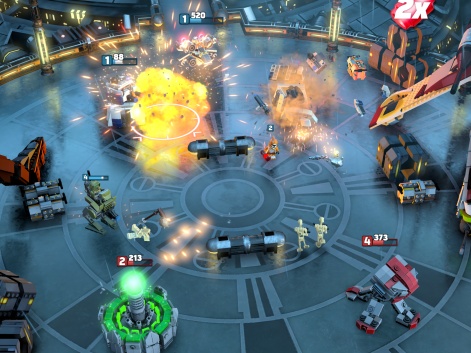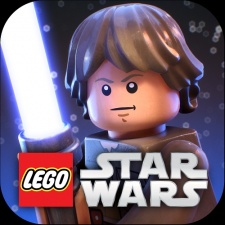No matter the size of the game or how long it ultimately takes to make, each new title involves a lot of hard work, tough decisions, and a little bit of luck before it even gets out the door and onto devices.
And that’s only the first step to making the title succeed.
To highlight the extensive work that goes unseen in the background, PocketGamer.biz is reaching out to developers to learn more about the process of releasing a video game, with our ‘Making Of‘ series.
This week, we spoke to TT Games Brighton studio head Jason Avent about the criticism and reinvention process LEGO Star Wars Battles underwent and the potential benefits of releasing a game via Apple Arcade.
PocketGamer.biz: Where did the initial idea for Lego Star Wars Battles come from?
Jason Avent: We were asked by TT Games to form a studio to work on Lego mobile games. We chose Lego Star Wars as we loved the movies and games that came before.
We didn’t feel that character-action, story-based games would work well on mobile and so, inspired by the epic battle scenes in the movies, we decided that a real-time strategy game would work best.
We needed to represent Lego building within the core game. From there, we invented the tower building, territory capture gameplay that sets Battles apart from other RTS games on mobile.
Inspired by the epic battle scenes in the movies, we decided that a real-time strategy game would work best.
Jason Avent
It was also important to make key characters like Darth Vader and Luke Skywalker stand out in the game, so we imbued each of them with a special ability power that players can trigger several times during a battle.
Using these well can make the difference between glorious victory and crushing defeat.
How long did development take, and how many people worked on the game?
We have a fairly small team that averaged out at about 25 across the development lifespan.
We formed a studio to make this game and so although we’ve been running for about three and a half years now, the production time is nearer to three years, including a significant amount of time in soft launch.
What was the biggest challenge you had to overcome during development?
Our retention figures were a little short of our ambitious targets at the start of the soft launch and so we looked again at the user testing results and had the team analyse the game over two days.
The game was already fun but we really drove for honesty and asked everyone to be as brutally critical as possible.
From there, we compiled a large list of improvements that would mean making radical changes. We also tried lots of alternative battle games in a kind of internal game jam. In the end, though, we mostly stuck with the original idea but made the arena smaller so battles were faster and more intense.
We changed the camera so the game looked better and you could see the characters more closely and we made everything a lot more readable and clear. We also changed a few of the core rules of the game – reinventing it in many ways.
This was an intense period of the project and it felt emotionally quite difficult to cruelly criticise your own creation. But ultimately the game was much improved and easier to play as a result.
At what stage in development did you feel you had a game that you were happy with?
We had a playable game within the first six months that one might recognise as similar to the game we have today.
We’ve ended up with a game that feels strategically different from all the other real-time strategy titles on mobile.
Jason Avent
But I don’t think I was totally happy with the game until we went through the criticism and reinvention process some way through the soft launch. I think the game we have today is great fun and easy to get into.
We’ve ended up with a game that feels strategically different from all the other real-time strategy titles on mobile. You win by either destroying the enemy’s base ship at the top of the map or by building more Lego towers than your opponent when the match ends.
You deploy your troops at the bottom of the arena and they advance towards the enemy base ship until they encounter resistance and start fighting. If you get troops past one of the five build pads on the map, then you can build one of the two towers you’ve pre-assigned to your deck.
The Lego bricks fly together to build each tower as you continue to play. Towers push the deploy line forward, closer to the enemy.
As you control more of the territory, you can bring your troops into battle further up the map and put pressure on your enemy. Equally, though, if your tower gets destroyed, you lose territory.

These mechanics feel very different and fun, especially combined with the triggerable battle abilities of your Champion characters like Darth Vader’s force slam and Yoda’s shield.
When was the decision made to launch the game via Apple Arcade?
Apple Arcade presents a strong opportunity for reducing the commercial risks and it’s a great way of finding an audience.
Subscription-based game services are becoming more prevalent and successful all the time. We were presented with the idea of moving to Apple Arcade in December 2020 and it immediately made sense to us.
We’ve spent the intervening time removing all the in-app purchases, optimising for Apple devices and porting the game to Mac and Apple TV.
We’re committed to supporting the game for a long time after launch
Jason Avent
We also added a few new features that the team wanted to cram in before launch. Now the game is balanced solely for subscribers and we don’t have to worry about designing in advantages and play paths for paying users.
Everyone is the same and only their skill and commitment will separate them in competition.
What can you tell us about your plans in terms of updates?
We’re committed to supporting the game for a long time after launch.
We’ve already planned content for the first year with new planets, champions, troops and strike cards. The events system means the game is refreshed monthly with new themes and ways to play.
I’m also anticipating regular balancing updates as players become creative and invent new strategies.

